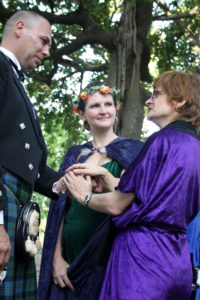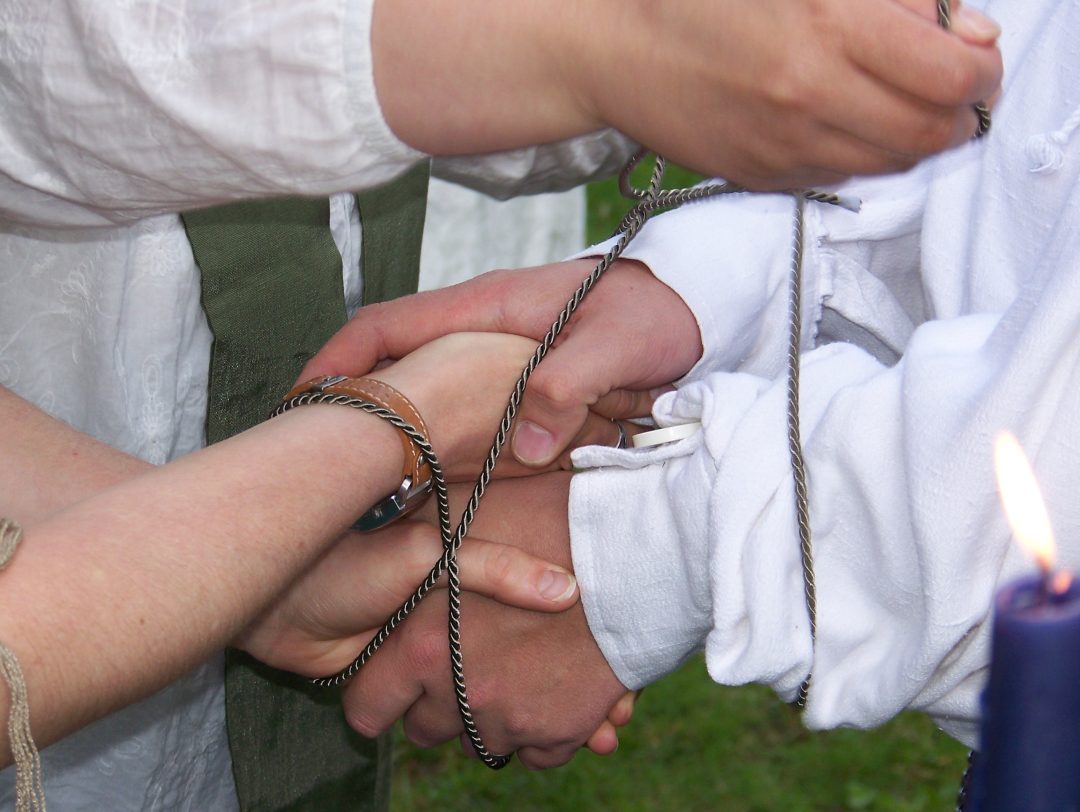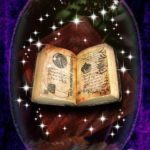The joining together of a couple through handfasting is a public celebration of their love and commitment to one another.
Handfasting is the Wiccan equivalent of a wedding, and represents a couple’s desire to be bonded together and have their love and commitment seen by family, friends and other practitioners of their spirituality. Handfasting may be temporary or permanent: for a year and a day (like an engagement), for life (like a wedding), or for eternity.
Handfasting comes from a Scottish custom, where a couple would have their hands tied together in a simple ceremony; if they were still together a year later, they were accepted as man and wife. This was still practiced in the 19th century.
In the last 50 years, it has become traditional to perform handfasting ceremonies at Beltane (Mayday) or at Litha (the Summer Solstice), these being the times when the weather is best and nature is at its most abundant and beautiful.
As with weddings, the exchange of rings in a handfasting ceremony signifies the couple’s desire to be faithful to each other and share the rest of their lives.
The design of the rings is entirely up to the couple, some people liking a Celtic design to go with the Scottish origins.
The tying together of the hands symbolizes the union of the couple and maybe the origin of the expression tying the knot’ that is used to describe marriage.
The handfasting cord is always red, which represents the passion, vitality and sexual love between the couple; they will keep it as a reminder of their vows.
The congregation gathers in a sacred circle for the handfasting ceremony. Everybody witnesses the tying of the hands and offers their blessings and then the party commences.
1. Casting the circle.
Before any Wiccan ceremony is performed, a sacred space is created. This is usually done by casting the circle and calling the elements.
When everyone is gathered in a circle, the officiating priestess will walk around the circle, starting and finishing in the east or north. She will usually mark the boundaries of the circle with a sword or athame (ritual knife).
The elements of air, fire, water, and earth, and the presiding deities, are invoked to be present and bless the ceremony.
2. Hand tying.
Once the circle has been cast, the bride and groom come forward to stand before the altar and have their hands tied together.
The groom stands on the left and the bride on the right. The groom’s right hand and the bride’s left hand been fastened.
3. Rings and vows.
The groom and bride are asked to repeat their vows in turn, which will be read by the presiding priestess and priest, or by close friends.
 This part of the ceremony is often done with the priestess reciting the vows for the groom to recite, and the priest reciting the vows for the bride to recite.
This part of the ceremony is often done with the priestess reciting the vows for the groom to recite, and the priest reciting the vows for the bride to recite.
When the vows have been recited, the rings are exchanged and placed on the ring finger of the left hand by each of the partners.
4. Element quest.
The couple will then go on a quest around the elements, starting with air in the east.
Those who invoked the elements give blessings, calling on the qualities of the element and asking that these always be present in the lives of the couple.
Once this is complete, the presiding Goddess and God are usually asked to bestow blessings on the couple by the priestess and priest.
5. The broomstick.
After the blessings, the couple has to jump the broomstick. A couple who are already handfasted or married is usually chosen to hold the broomstick.
The broom is raised and lowered as the new couple prepares to jump, to bring in an element of humor, though it is lowered to about a foot off the ground so the couple can just it easily with their hands tied together.
Cakes and wine are then blessed and shared by the couple and passed around the circle. The Goddess, God, and elements are thanked and bid farewell, the circle opened (the reverse of the casting), and the celebrations commence.






